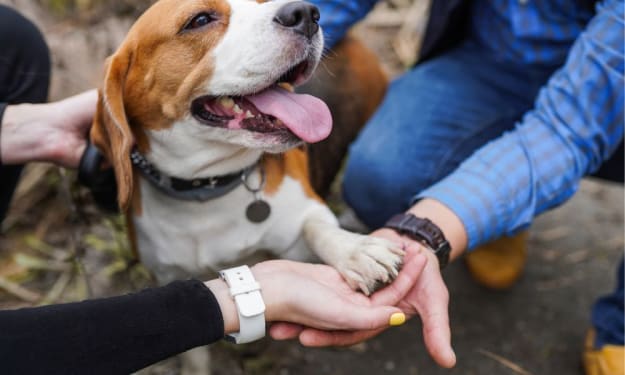Have you ever wondered how dogs are trained to be obedient and help in carrying out tasks? See these strategies now!
Top secrets of training dogs

Here are some strategies for training dogs to carry out tasks:
Note, if you want your dogs to perform better, you will need to buy the books suggested below!
Strategies for Training Dogs:
1. Start with Basic Commands: Teach your dog basic commands like "sit," "stay," "come," and "down" using positive reinforcement techniques like treats and praise.
2. Use Positive Reinforcement: Reward good behavior with treats, praise, and playtime to encourage your dog to repeat the desired behavior.
3. Consistency is Key: Use the same command and reward system every time to create consistency and reinforce the desired behavior.
4. Gradually Increase Difficulty: Once your dog has mastered a basic command, gradually increase the difficulty by adding distractions or introducing new commands.
5. Keep Training Sessions Short: Dogs have short attention spans, so keep training sessions short and frequent to prevent them from becoming bored or overwhelmed.
6. Use Clicker Training: Clicker training is a positive reinforcement technique that uses a distinct sound to signal to the dog that they have performed a desired behavior correctly.
7. Use Verbal and Visual Cues: Use verbal cues like "good boy/girl" and visual cues like hand signals to reinforce the desired behavior.
8. Keep Training Fun: Incorporate playtime and games into your training sessions to keep your dog engaged and motivated.
9. Be Patient: Remember that training takes time and patience, so be patient and persistent with your dog.
buy the detailed and complete books here:
1. Puppy training basic books and strategies
2. Train your parrot all tricks to speak, understand and remember
3. The top secrets to training dogs
All these books are already confirmed to be effective.
It only takes you few months to train your pets with these books.
Here is a broad explanation on the strategies for training dogs
Training a dog can be a rewarding experience for both you and your furry friend, but it can also be challenging if you don't have a clear plan. To ensure success, it's important to have a strategy in place and follow some basic guidelines. Here are some strategies for training your dog:
1. Start with Basic Commands: One of the first things you should teach your dog are basic commands such as "sit," "stay," "come," and "down." These commands are essential building blocks for more advanced training later on.
2. Use Positive Reinforcement: Positive reinforcement is a powerful tool for encouraging good behavior in dogs. Reward your dog with treats, praise, or playtime when they exhibit desired behaviors.
3. Consistency is Key: Dogs thrive on consistency, so it's important to use the same command and reward system every time. This helps to reinforce the desired behavior and prevent confusion.
4. Gradually Increase Difficulty: Once your dog has mastered a basic command, gradually increase the difficulty by adding distractions or introducing new commands. This helps to keep your dog engaged and challenged.
5. Keep Training Sessions Short: Dogs have short attention spans, so it's important to keep training sessions short and frequent. This helps to prevent them from becoming bored or overwhelmed.
6. Use Clicker Training: Clicker training is a positive reinforcement technique that uses a distinct sound to signal to the dog that they have performed a desired behavior correctly. This can be an effective way to communicate with your dog and reinforce good behavior.
7. Use Verbal and Visual Cues: In addition to using a clicker, you can also use verbal cues like "good boy/girl" and visual cues like hand signals to reinforce the desired behavior.
8. Keep Training Fun: Incorporating playtime and games into your training sessions can help to keep your dog engaged and motivated. Remember, training should be a fun experience for both you and your dog.
9. Be Patient: Training takes time and patience, so it's important to be patient and persistent with your dog. Remember to celebrate small successes along the way.
10. Consider Your Dog's Personality: Every dog is different, and what works for one dog may not work for another. Take your dog's personality and learning style into account when developing your training plan.
11. Don't Use Physical Punishment: Physical punishment can harm your dog and damage your relationship with them. Stick to positive reinforcement techniques to encourage good behavior.
12. Use Treats Wisely: Treats can be a powerful motivator, but use them wisely to avoid overfeeding and potential health issues. Use small, healthy treats and avoid giving too many.
13. Timing is Important: Timing is critical when it comes to training. Reward your dog immediately after they exhibit the desired behavior to reinforce the behavior and make the connection between the behavior and the reward.
By following these strategies, you can establish a strong bond with your dog and build a foundation for a lifetime of good behavior.
About the Creator
Enjoyed the story? Support the Creator.
Subscribe for free to receive all their stories in your feed. You could also pledge your support or give them a one-off tip, letting them know you appreciate their work.





Comments (1)
Love people in need of knowledge for they shall find and be free❤